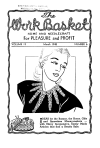The Workbasket Vol. 13 No. 6

I-WB136 The Workbasket Vol. 13 No. 6 March 1948
Crocheted collar in white, crocheted rug in two shades of blue, yellow and orange, crocheted glass coasters, knitted scalloped baby set of sweater, bonnet and bootees, crocheted blouse trim, tatted medallion, crocheted edging, crocheted primrose doily, household tips, crocheted flower frog closure, textile painting, crocheted luncheon set, Aunt Ellen’s Club Notes, crocheted flower sprays, knitted lace vanity set, crocheted braid trim, crocheted round doily.
Softcover stapled, 24 pages.
From the collection of Sarah Dalton, scanned by Seya Wijnsma-Spek, edited by Sytske Wijnsma. Published with kind permission of F+W Media, the current copyright holder.
One would conclude that crochet was more popular than knitting with the subscribers to the Workbasket, based on the number of crocheted items versus those in other techniques. The necessary tools are simple and cheap, and if buying a crochet hook is a problem, any strong wire with the edge bent around will do. In fact the very early crochet hooks were just that, pieces of wire bent at the end and fixed in a handle that could accommodate several sizes of hooks. In antique needlework kits there’s one handle and six or so hooks of the bent-wire type, often with a screw thread at the other end that fit the counter screw in the handle. Alas, the screw threads were not normalized so once the handle is lost, you’d be fortunate to find another that fits. In that respect the tambour hook holders are more flexible, just tighten the screw until the hook is firmly fixed.
 Three bent-wire crochet hooks with a screw thread at the end.
Three bent-wire crochet hooks with a screw thread at the end.
We can count ourselves lucky with so many cheap but strong hooks available, and so many crochet patterns in our catalog!
FUNDRAISING